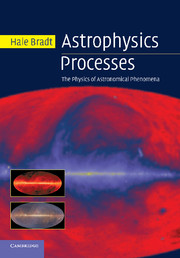Book contents
- Frontmatter
- Contents
- List of figures
- List of tables
- Preface
- Acknowledgments
- Also by the author
- 1 Kepler, Newton, and the mass function
- 2 Equilibrium in stars
- 3 Equations of state
- 4 Stellar structure and evolution
- 5 Thermal bremsstrahlung radiation
- 6 Blackbody radiation
- 7 Special theory of relativity in astronomy
- 8 Synchrotron radiation
- 9 Compton scattering
- 10 Hydrogen spin-flip radiation
- 11 Dispersion and Faraday rotation
- 12 Gravitational lensing
- Credits, further reading, and references
- Glossary
- Appendix: Units, symbols, and values
- Index
11 - Dispersion and Faraday rotation
Published online by Cambridge University Press: 05 June 2012
- Frontmatter
- Contents
- List of figures
- List of tables
- Preface
- Acknowledgments
- Also by the author
- 1 Kepler, Newton, and the mass function
- 2 Equilibrium in stars
- 3 Equations of state
- 4 Stellar structure and evolution
- 5 Thermal bremsstrahlung radiation
- 6 Blackbody radiation
- 7 Special theory of relativity in astronomy
- 8 Synchrotron radiation
- 9 Compton scattering
- 10 Hydrogen spin-flip radiation
- 11 Dispersion and Faraday rotation
- 12 Gravitational lensing
- Credits, further reading, and references
- Glossary
- Appendix: Units, symbols, and values
- Index
Summary
What we learn in this chapter
Radio waves traversing the interstellar medium (ISM) reveal a great deal about the medium because the waves are modified by plasmas and magnetic fields during their transit through the Galaxy. Dispersion is the variation with frequency of the group velocity of a radiation pulse. The measured spread of arrival times is directly related to the dispersion measure (DM), which is the integral of the electron density ne along the line of sight.
Faraday rotation is the rotational displacement of the electric vector of linearly polarized (LP) radiation about the propagation direction. The measured quantity, the rotation measure (RM), is the integral along the propagation path of the product neBz, where Bz is the component of the galactic magnetic field B parallel to the propagation direction.
The relations between the interstellar quantities and these two phenomena follow from Maxwell's equations as they apply to a dilute plasma. Their solution leads to a frequency-dependent phase velocity in terms of the dielectric constant of the medium. The square root of the latter is the frequency-dependent index of refraction. This in turn leads to the dispersion relation – a relation between the index of refraction, frequency, and wavelength. […]
- Type
- Chapter
- Information
- Astrophysics ProcessesThe Physics of Astronomical Phenomena, pp. 400 - 436Publisher: Cambridge University PressPrint publication year: 2008



